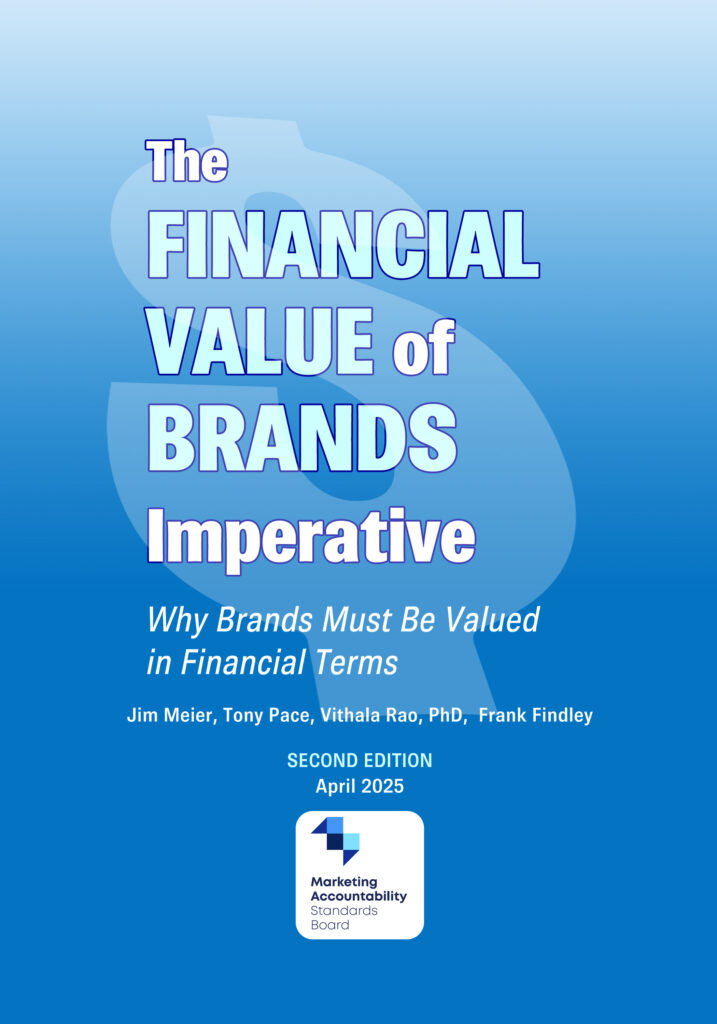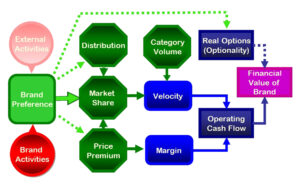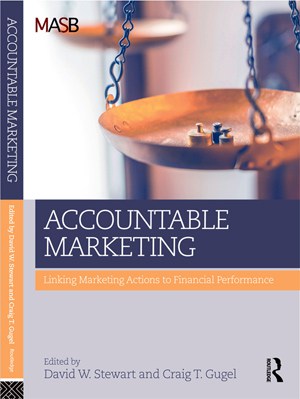With some exceptions, MASB publications may be downloaded for free with registration. Members can avoid registration through MEMBER ACCESS.
The Financial Value of Brands Imperative: Why Brands Must be Valued in Financial Terms | 2nd Ed.
Meier, Findley, Pace, Rao • April 2025
 “Marketing exists to drive profitable and sustainable growth through increased demand. Since growth is measured in financial terms, the strength of brands and the resulting customer franchise must also be expressed and analyzed in financial terms. Regular measurement and analysis of the financial value of brands demonstrates the material contribution of brands to the overall value of the enterprise, an excellent decision- making tool to enhance long-term enterprise value.”
“Marketing exists to drive profitable and sustainable growth through increased demand. Since growth is measured in financial terms, the strength of brands and the resulting customer franchise must also be expressed and analyzed in financial terms. Regular measurement and analysis of the financial value of brands demonstrates the material contribution of brands to the overall value of the enterprise, an excellent decision- making tool to enhance long-term enterprise value.”
- Why Brands Must be Valued in Financial Terms
- The Brand Value Accounting Dilemma
- Emerging Best Practices
- The Path Forward
FVB Measurement Provider Summaries: Brand Finance, Kantar BrandZ, Interbrand, Ogilvy Consulting, and Presciant
Additional content:
Measuring Brand Equity and Brand Value
terms from the Universal Marketing Dictionary
The Bud Light Brand Divorce
Order from AMAZON Order from BARNES & NOBLE
The Financial Return on Creativity – The Case of Advertising
Bauer, Koslow, Matta, Stewart • October 2024
 The importance of innovation and creativity in business and in society has long been recognized. Creativity is generally viewed as a critical element in marketing and advertising – a catalyst for brand recognition, an anchor for consumer memory, and a bridge that connects the commercial message to the audience’s emotive landscapes.
The importance of innovation and creativity in business and in society has long been recognized. Creativity is generally viewed as a critical element in marketing and advertising – a catalyst for brand recognition, an anchor for consumer memory, and a bridge that connects the commercial message to the audience’s emotive landscapes.
However, there are concerns about current investment in creativity, its contributions, and its effectiveness, at least as measured by financial performance. Even if creative talent is available, are enough time and resources being invested? MASB has an initiative to answer this question, and this review of the literature – with respect to the definition of, management of, and financial return on creativity in advertising – is the first step.
The Bud Light Brand Divorce 2nd Ed. • Meier, Findley • June 2024
Compiled from a series of four articles published between May 2023 and March 2024, this paper describes how impaired brand preference led to persistent sales volume decline at AB InBev, parent company to the Budweiser® and Bud Light® beer brands, after sponsored Instagram posts promoting Bud Light were met by a wave of criticism on social media.
Former marketing finance executive and current MASB Trustee/Treasurer Jim Meier and MASB Executive Director Frank Findley relate how MASB’s landmark Brand Investment & Valuation study (March 2016) concluded that this would be the case, despite most news coverage downplaying the likelihood of a significant monetary impact to AB InBev and Bud Light.
Sponsorship Accountability: A Roadmap for Sponsorship Marketing Success
Ebben, Pace, Katz, Findley, Christensen, Wokosin • May 2024
For many sponsorship marketers, accountability based on the business impact of mid-funnel Return-On-Objectives (ROO) measures has remained elusive. MASB shares recommendations to improve the accountability of sponsorships and identifies practices that improve value, including a measurement approach that is independent, objective and marketer directed, along with guidance on mid-funnel ROO measures that make quantification attainable. Topics include: strategy and brand fit, business case and contractual considerations, activation & stewardship, measurement, eSports, and Name, Likeness & Image (NIL).
ORDER from AMAZON (paperback or e-book)
ORDER from BARNES & NOBLE (paperback or e-book)
Measuring Financial Return on Creativity • Stewart • November 2023
 Creativity is inherently somewhat risky from a financial investment perspective, and there are unique and fascinating issues around the management of creativity. With the Measuring Creativity Initiative, MASB is attempting to define creativity and identify what makes great creative. We’re working with CMO, CFOs, CEOs and agencies to identify research, case studies and benchmarks, to create a model to help companies and agencies successfully manage the creative process to produce measurable financial results. The initiative is fundamentally concerned with marketing effectiveness. The primary question is not what makes an ad more or less creative. Rather, the focus of the initiative is the contribution of creativity to making marketing actions more effective.
Creativity is inherently somewhat risky from a financial investment perspective, and there are unique and fascinating issues around the management of creativity. With the Measuring Creativity Initiative, MASB is attempting to define creativity and identify what makes great creative. We’re working with CMO, CFOs, CEOs and agencies to identify research, case studies and benchmarks, to create a model to help companies and agencies successfully manage the creative process to produce measurable financial results. The initiative is fundamentally concerned with marketing effectiveness. The primary question is not what makes an ad more or less creative. Rather, the focus of the initiative is the contribution of creativity to making marketing actions more effective.
Effectiveness and Efficiency of TV’s Brand-Building Power: A Historical Review
Findley/Johnson/Crang/Stewart • December 2020

Radical changes continue to shape the media landscape. Although much recent research has been conducted on the effectiveness of new media platforms, less attention has been given to that media-plan staple—television advertising. A common question in media planning revolves around whether television is as effective in 2017 as it was in the 1980s or whether its role has diminished to the point of being nonviable. Even if television remains an effective advertising medium, there are questions about how television compares with the many other media-platform alternatives available today.
Proving the Value of the Brand • Pace, Diorio • July 2019
The value of a brand, creating it, maintaining it or, even better, growing it, is of significant importance to any enterprise that currently has brands. Brands influence customer choice, and the power of a brand’s attraction influences sales today and tomorrow. And yet the measurement of brands and their value remains a complex topic to explore, with many divergent points of view. The totality of a brand’s value often only comes into focus when an acquisition occurs and the acquiring entity must establish a value to put on its balance sheet to account for the brand or brands it acquired. So, if book value for brands generally understates their value and other proprietary methodologies contain assumptions that can be debated, is work to value a brand still inherently worthwhile?
Applying the Brand Investment & Valuation Model
Meier, Stewart, Findley • May 2018

Two key aspects differentiate the MASB BIV Model from other brand valuation models. First, it incorporates a behavioral measure of brand strength in the hearts and minds of customers, brand preference. Second, it establishes mathematical linkages from customer brand strength to brand monetary value.
This empirically proven framework provides Finance and Marketing teams a practical approach for monitoring the value of their commercial brands. Its positive reception has fueled demand for information on how to deploy it. This version updates the original May 2017 release with new material addressing environmental factors such as changes in tax and interest rates.
 Television’s Brand-Building Power – from GRPs to PRPs
Television’s Brand-Building Power – from GRPs to PRPs
Findley, Johnson, Crang • Oct 2017
Radical changes continue to shape the media landscape. While much research has been conducted on the effectiveness of new platforms, less attention has been given to that media plan staple – television advertising. Is TV as effective as it was in the 1980s? Or has its role diminished to the point of non-viability? If still effective, how does it compare to other media platform options available today?
DOWNLOAD PDF
Perspective on Ad Capitalization and Taxation • Moore, Stewart • 2016
Expenditures that have a life of less than a year are treated as current expenses while expenditures that have a life of greater than a year are capitalized and amortized over the useful life. Advertising expenditures are treated as short-term and expensed in the current year. Several proposals have been made to change the treatment of advertising to treat all advertising as having some long-term effect on sales. This paper examines research in economics, marketing and accounting that has addressed the short- and long-term effects of advertising on sales.
DOWNLOAD PDF
Brand Investment and Valuation: A New, Empirically-based Approach • Findley • 2016
The “brand” is one of the largest assets that a company owns. But unlike tangible assets like factories which are quantified on the balance sheet, a brand’s financial value often goes unrecognized. This puts marketing and finance teams at a disadvantage for assessing investments in the brand such as media. To bridge this gap MASB sponsored an ambitious project that brought together leading academics, marketing and finance practitioners from six blue-chip corporations, and specialists from several research companies.
DOWNLOAD PDF

Designed to be the definitive volume on the emerging role of accountability and performance metrics in marketing, Accountable Marketing provides a multi-disciplinary, international perspective on this topic of critical importance. It not only emphasizes the importance of accountability in the marketing function, but also creates a dialogue among academics and practitioners about the importance of marketing in driving consistent growth in the organization, and the ways in which improved methods for measuring and forecasting contribute to the effectiveness of these marketing activities. This marks the first-ever reference point for practicing professionals, faculty and students interested in marketing accountability, the development of standards for marketing reporting, and developing stronger linkages between marketing activities and the financial performance of the firm.
What Is Known About the Long-Term Impact of Advertising • Hanssens • 2011
The focus of most measures of marketing’s impact on sales is “short term.” Measurement and analyses that consider only short-term impact may put advertising at an unrealistic disadvantage when allocating marketing resources to maximize long-run profitability. This paper reviews what is known about the short- and long-term impact, illustrates the findings with practitioner examples, and provides clear direction for business application and improving financial return. (Ch. 8, Accountable Marketing: Linking Marketing Actions to Financial Performance)
DOWNLOAD PDF
Getting a Seat at the Table: C-Level Views on Marketing ROI • Plummer, Blair • 2009
In the absence of standardized metrics for determining marketing’s contribution to return on investment and bottom line, the key to accountability may be found in the behaviors of other business functions—primarily finance and operations—which have established independent, self-governing standards bodies.
DOWNLOAD PDF


